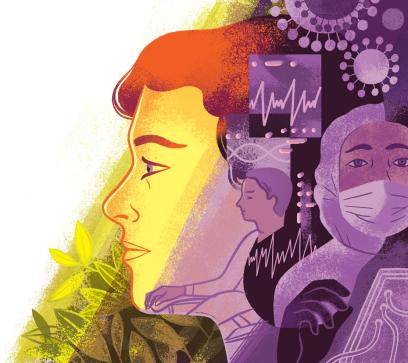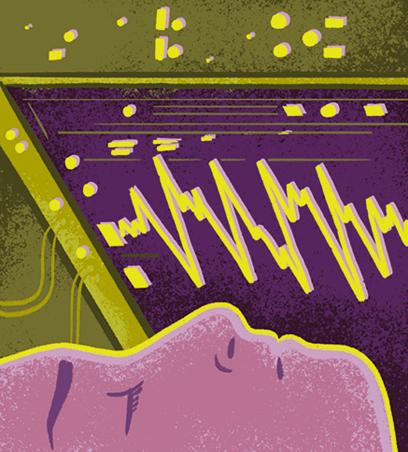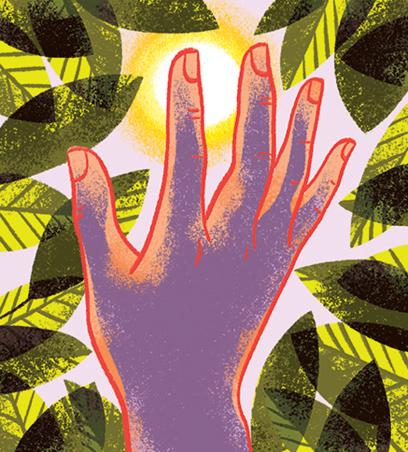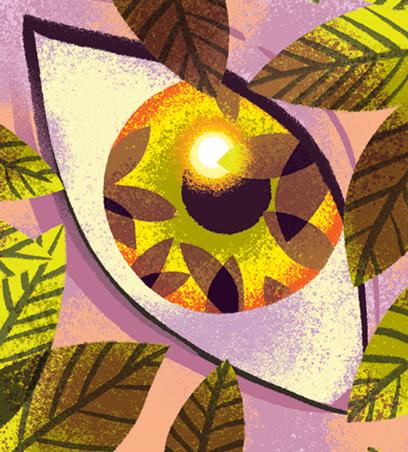I stand in my garden at home on a clear spring day, several weeks into the United Kingdom’s COVID-19 lockdown. On the radio, our prime minister has been telling us we must continue to “stay at home” to “slow the spread of infection.” Having spent five years as a nurse and now on a year of maternity leave, I feel a sense of guilt knowing that my dear friends are on the frontline while I am at home. I am, of course, fulfilling my own vital role—bringing up my new baby daughter—but seeing the United Kingdom mobilize a field hospital able to hold as many as 4,000 patients, I wonder if I should be there, too.
My colleagues have told me they are going to stage a walkout due to the lack of personal protective equipment provided by the government. I’ve seen them on the news commemorating Workers’ Memorial Day, fists held high, banners out, demanding not better pay but simple face masks and gowns to protect themselves. Still, there are moments when I realize I’m fortunate to be in the UK. Friends and colleagues in the United States are struggling with all of these problems and more: a disjointed healthcare system with millions of people uninsured and a president who has not only avoided responsibility but also recklessly suggested that people inject themselves with disinfectant.
I have been commissioned by the chief nurse of the National Health Service in England to write some words on the strength of our healthcare workers—a poem that I hope goes a small way to showing staff they are seen and heard. I spent three years studying for a degree in English literature and creative writing and have been fortunate to be able to combine nursing and writing after my poem “Nursing the Nation,” which I wrote and performed while still a nursing student, went viral on the internet. It is such a joy to be able to both look after people and write for a living.
Standing in my garden, I close my eyes and feel the warmth of the spring sunshine on my skin, hear the sound of birdsong, draw fresh air into my lungs. As I consider these simple gifts, I am taken back to my previous job—working as a registered nurse in intensive care, where life and death are always present for both patients and staff—and to a patient who reminded me, in the midst of all of his own frightening uncertainty, to slow down and remember the small things that make life worth living.
A New Assignment
In 2018, I spent a long, challenging six months learning how to look after patients with external ventricular drains in their brains, on ventilators or dialysis machines, with balloon pumps controlling the flow of blood through their aortas and drugs that had to be minutely titrated because a small mistake could mean the difference between life and death.
The environment in the intensive care was wildly different from where I had spent the previous two years working—in a cardiothoracic high-dependency unit where I welcomed in cheery, suitcase-dragging elderly patients, prepared them for surgery, and nursed them back to full and often better health, with shiny new heart valves and clean coronary arteries. The patients in the cardiothoracic unit had not suffered great trauma. They could be unwell—breathless and in need of surgery—but they could see an end to their hospital admission once the operation was complete. The ward was light-filled, the windows tall, beaded with rain or glinting in the bright sun, and the trains rushing past outside reminded us all, patients and nurses, of faraway places that we could one day go to again.
But intensive care was located at the back of the hospital. To get there, I had to walk through a glass tunnel where the daylight streamed through. It reminded me of the Ocean Tunnel at the Sea Life London Aquarium, where I gazed up as a child hoping to see a shark in the gloom amid the smooth white underbellies of rays and the neon-streaked scales of tropical fish. Here at the hospital, the sky above the tunnel was crisscrossed with netting that trapped birds, their feathers and splayed wings caught in the holes. Even so, I always made sure to walk through the tunnel on my break because inside the intensive care unit there were no windows or natural light. There was only muted fluorescent lighting and the glow of the screens and monitors and flashing infusion pumps that we huddled around in the near-dark.
In the twilight of the ICU, patients died all the time. It seemed full of trauma and sadness. Patients forever brain-damaged from unsuccessful attempts at suicide. Young racecar drivers now unable to do more than blink, their careers ended just as they were beginning. Drug addicts with hearts that no longer pumped, leaving them fluid-filled and coughing up froth. Traffic accidents that brought two devastated families suddenly careening toward each other in the waiting room.
Working in the ICU was an eye-opening experience in my nursing career. My colleagues were at the top of their game, able to look after patients attached to many flashing, organ-supporting machines. But to me, an intensive care rookie, even the mundane routines were mesmerizing. I watched how patients with breathing tubes down their throats had their teeth brushed by the staff day and night. This process involved a nurse carefully holding the breathing tube steady with one hand while wielding a syringe of water, a dab of toothpaste, and a suction tube with the other to thoroughly clean the patient’s mouth. It was nerve-racking to watch, and I marveled at how skilled the nurses were. The way they performed these small but vital tasks often astounded me the most.
I soon came to learn that on the ICU, at least the first half-hour of the shift is dedicated to a full body survey, the ABCDE assessment. Airway, Breathing, Circulation, Disability, and Exposure. I was used to this type of examination, which is a fundamental part of nursing care, but in other wards we each cared for multiple patients and often had to move quickly. Here, we looked after a single patient. I was amazed at the depth and time given to each part of the process. Behind the blue paper curtains, where the strip lighting becomes moonish and soft, the nurse observes—and tries to perceive—the patient they are to spend the entire shift with, listening to the chest with a stethoscope, feeling the rise and fall, watching the settings on the ventilator, observing the flow of oxygen. One patient, 12 hours, 11 bodily systems to navigate, monitor, and record on the bedside computer. For those 12 hours, the nursing team must become experts in that patient’s topography, their steep declines and rocky recoveries, the overnight brain-storms, the flare in the eye that finally opens, the longitude and latitude of swollen limbs, new wounds opening up like crimson calderas. The patient might drift, but we cling tightly to them, one constant amid a forever-changing current.
A New Patient
Four months into my new role, I felt thick with the trauma and sadness I had seen. During handover one shift I was assigned a young patient, Owen, who had suffered extensive burns; going to retrieve his stray soccer ball, he had fallen down a grassy bank and landed on railway lines, where he was electrocuted. He was airlifted to our hospital and was found to have sustained burns over 35 percent of his body. His legs were stripped of skin and muscle, burnt down to the bone. He was taken straight to the operating room, pieces of skin from his arms and buttocks cut away and sewn to the raw, bare flesh of his legs. He was wrapped and bandaged and kept in an induced coma until the swelling, and the pain, became more bearable. Over our morning coffee, we were told that he was no longer on a ventilator but was unable to move his lower body. Our task was to manage fluid loss and replenish and build his strength, with the aim of getting him to walk again.
I went to his bedside. Owen’s eyes were closed, but I didn’t think he was asleep. I introduced myself and told him I would be with him for the day. May I take your observations? A small nod. I made sure I was quiet as I conducted the ABCDE assessment, letting him rest from everything he had been through.
Airway
Owen was able to speak, but he didn’t. I had not looked after Owen when he was ventilated. I watched and listened as my colleagues did so, moving around his bedside quietly and carefully, replacing the filter, the suction bags, the tubing. It took a long time for me to feel confident looking after people with breathing tubes, their lives held literally between the nurse’s fingertips. It required patience, concentration, and much skill. Overnight when the lights were dimmed, I was fascinated by how my fellow nurses worked, their hands fluent in the workings of the human body despite the dark.
Now, Owen was able to draw breath without assistance but needed help to cough up the remnants left behind in his lungs. I watched him in silence before moving on with the assessment. He was quiet; there were no signs of obstruction, no need for suctioning. His airway was patent. He could breathe. For healthcare practitioners, A—the airway—represents the first part of the assessment and one we continuously monitor. Without a patent airway, a patient is not able to survive.
Breathing
I looked at the way Owen’s chest rose and fell. As nurses we are taught to look, listen, and feel in order to assess the intricacies of breath. How fast are the respirations? What sound does the breath make as it passes through the lungs? Is it shallow? Are the muscles around the neck brought in to assist in the work of breathing? Is the patient, therefore, struggling?
During the accident, Owen had suffered a blunt chest trauma, falling and landing awkwardly on his side so that a rib cracked and punctured his lung. In the operating room they had inserted a chest drain to reinflate his lung and reduce the fluid that had leaked into the wrong space. I walked around the side of the bed to where a single lantern-shaped bottle hung, filled with sterile water to maintain subatmospheric pressure in the space being drained. If this subatmospheric seal were left unclamped, the drainage tube would suck and spit like a muddy sump pooling in Owen’s chest, allowing air to reenter. I checked the suction and recorded the drainage on Owen’s notes. It had become my habit to look back through the patient’s notes after I did so, to see how far they had come from when they first arrived. On a particularly challenging day in intensive care, this reflection would remind me that patients could improve, that there could be small victories, that there was progress in less suctioning required and less oxygen being consumed. I looked back at Owen’s notes to remind myself of the progress he had made in our care.
Circulation
This was my favorite part of the ABCDE assessment—so much can be learned about a patient by understanding how the blood moves through their body. In my studies of literature, I had felt similarly drawn to the mysteries and movings of our corporeal substance, the lifeblood that carries with it our histories and stories to pass on.
In humanities classes I read about blood in many forms, studying the greats of Western literature. I knew how blood stirred before Shakespeare’s Henry V led his men into battle, how it soaked through cloth in the flickering candlelight as Jane Eyre was woken in the dead of night to tend to an injured limb, how in Dostoevsky the smell of it, sticky and warm, might conjure thoughts of a murder somewhere up ahead. Now, working as a nurse, these images of blood and its power to make or unmake a life animate many of my shifts.
Owen had lost blood and leaked fluid from the burns in his legs. When he arrived at the hospital, he was hypovolemic. Even in the months following his admission, the care we provided entered my thoughts and dreams, the fast-paced replacement of fluid bags and electrolytes to keep his organs working, running blood gases and nervously checking the results, wrapping his wounds, documenting his vital signs every 15 minutes. I looked at the color of his skin, felt his pulses, checked his heart rate and rhythm, tested his capillary refill. Everything looked good, reassuring me that his organs were getting enough blood supply.
Owen was more than his vital signs. On the railway tracks he had been catapulted from the earth, emptied of fluid, then at the hospital refilled and stitched back together. His lifeblood, carrying all its iron and minerals, old stories and memories, had been cast out, forever changed from crossing its cellular border. Owen, too, would be changed after this experience, after glimpsing—if just for a moment—the fast-flowing conduit between two worlds.
Disability
On a previous shift the nurse had reported that she had seen a change in one of Owen’s pupils, leading the team to wonder whether he had sustained a head injury in addition to the damage to his legs and chest. In the early hours, the nurse took her penlight and shone it into Owen’s eyes every 15 minutes, hoping to see his pupils wax and wane, letting in or shutting out light. Instead, she found one pupil a little larger than the other. The doctors were called, and we nurses were instructed to watch and wait.
How we see our universe depends on our eyes and our experiences. If we suffer a traumatic injury to our brains, our pupils can become dark pools, fixed and dilated, no longer able to absorb anything before them. Medical professionals often refer to this kind of presentation as a blown pupil, staring forward wide and motionless like a black hole swallowing the light.
The ancient Greeks believed we held a divine fire within our eyes that cast outward, illuminating anything we wanted to see. As morning came, Owen’s pupils had returned to normal, as if overnight his fire had begun to dwindle before an ember caught again, sparking back to life.
Exposure
The skin on Owen’s thighs was gone. What replaced it were two bare patches of red tissue with new skin sewn on. The surgeons wanted to give his body time to get used to the skin grafts before attempting any more repair. It was likely he would need some artificial grafting since the damaged area was so large.
I had almost finished the ABCDE assessment when a voice behind the curtain asked if it was okay to come in. I covered Owen with his sheet and said it was. It was the physical therapist, Sarah. Every day, she asked Owen if he wanted to go outside in his wheelchair. Each day so far he had said no. But today that changed. He opened his eyes, licked his lips, and whispered, “Okay.”
It took two nurses, a healthcare assistant, and the physical therapist to get Owen into his tilting wheelchair and push his equipment out of the ICU, into the elevator, and to the front of the hospital. Next to the parking lot there were some flowers and shady trees with the sun filtering through. We wheeled him there and put the brakes on, checking his vital signs on the portable monitor.
Sarah tilted Owen’s chair so that he could see the sky. He lay there for a good 10 minutes. We weren’t sure if it was too bright for him or if he had fallen asleep. His lips looked dry, as if he had been out in the sunshine for the whole afternoon. After a while, I asked if he was okay. He opened his eyes, and I realized it was the first time I had properly seen their color. They were green and speckled with yellow, like a cat’s eyes.
“Yes,” he said. His voice was quiet. I thought that was all he was going to say, but then he closed his eyes again.
“I’m just feeling it,” he said, and paused again.
“Feeling it?” I said, worried he meant a missed heartbeat or a pain in his legs.
“Life,” he said. “I can feel life on my skin.”
In that moment sunlight streamed across his face. He didn’t flinch. He smiled as if soaking it all in. We had never seen him smile.
We looked at each other and could see we were all holding tears in our eyes. We kept Owen out in the spring sunshine as long as the oxygen tank lasted, and when we told him we had to go he made us promise we would come back the next day, just to the hospital parking lot, to feel life on his skin. We promised we would.
A New Perspective
Owen stays with me, all these months later, when I’m standing in the garden, hearing our leaders on the radio, listening to the birds, thinking of the sacrifices healthcare workers are making, and feeling the sun on my skin. I think, too, of how our healthcare service might be transformed after this pandemic, after the sickness has passed and we are all changed as a result.
In its wake we might just see sweeping transformations in the way healthcare is delivered across the globe. In the midst of this crisis we have seen a dramatic increase in the use of technology, digitalizing how we offer care with phone and video consultations freeing up in-person time slots for sicker patients. China harnessed technology during the COVID-19 outbreak, using artificial intelligence to detect fever in pedestrians through a touchless technique.1 What if healthcare providers across the world were able to capitalize on technology, using electronic patient notes (easily and securely transferred among providers), online pharmacy transactions, disease tracking and observation, and telemedicine for those who live in rural locations or are hard to reach? These technologies suggest one way we may see reformed healthcare systems that are better able to focus on prevention: allowing systems to “talk” to one another. By connecting digital systems, different areas of health and social care could work together, supporting wellness both in the community and within the hospital setting, contributing to cost efficiency, and helping to provide high-quality care for all. Imagine this: a patient takes control of their own long-term condition by downloading ECG data from their smartwatch and sending the information directly to their care provider to review. From there, the medical professional can interpret the diagnostic and respond quickly and efficiently, speaking to the patient, prescribing as necessary, and documenting care online.
While there are many possible avenues for improvement in the system and for how we care for one another in our communities, it’s clear that changes are needed. The response to COVID-19 has highlighted the cracks in our healthcare finances, supply chains, preparedness, and more—but in the face of it, it has also highlighted the shining value of healthcare staff.
Here in the UK, the National Health Service (NHS) is the fifth-largest employer in the world, behind McDonald’s, Walmart, the Chinese People’s Liberation Army, and the US Department of Defense.2 The NHS is a nonprofit, tax-funded health system. Spending on healthcare in the UK as a percentage of gross domestic product is far below that of countries like the United States with much larger economies.3 Despite this, the British health system is world-envied for its nondiscriminatory, free at the point of service delivery approach. Every 36 hours, the NHS looks after 1 million people.4 And yet the number of nurses who have left the NHS due to poor work-life balance has almost tripled in the last decade—and there are an estimated 50,000 nursing vacancies in the United Kingdom.5
COVID-19 has taught us that through these uncertain times, through months of social distancing and isolation, we can learn the most from our nurses, doctors, respiratory therapists and other healthcare providers, and healthcare assistants who have given their all. Perhaps in seeing how they have responded, how they have continued to provide care despite lacking so many resources that their jobs require, governments around the world will come to understand their undeniable value and truly learn how to treat people.
Molly Case is a spoken-word artist, writer, and nurse. She was born and raised in London, where she currently works at St. George’s Hospital as a cardiac nurse specialist. In addition to her memoir, How to Treat People: A Nurse’s Notes, she has written for the Guardian, the Independent, Elle magazine, and HuffPost. © Molly Case 2020. How to Treat People by Molly Case is published by W.W. Norton & Company.
Endnotes
1. P. Jakhar, “Coronavirus: China’s Tech Fights Back,” BBC News, March 3, 2020, www.bbc.com/news/technology-51717164.
2. S. Minter, “Who Are the World’s Biggest Employers?” Industry Week, June 24, 2015, www.industryweek.com/talent/article/21965429/who-are-the-worlds-biggest….
3. B. Sawyer and C. Cox, How Does Health Spending in the U.S. Compare to Other Countries? (Peterson-Knight Family Foundation Health System Tracker, December 2018), www.healthsystemtracker.org/chart-collection/health-spending-u-s-compar….
4. “The National Health Service,” Royal College of General Practitioners, 2020, www.rcgp.org.uk/training-exams/discover-general-practice/overseas-docto….
5. L. Donnelly, “Number of NHS staff leaving for a better work/life balance triples,” Telegraph, March 27, 2019, www.telegraph.co.uk/news/2019/03/27/number-nhs-staff-leaving-better-wor…; and Royal College of Nursing, email message to editors, May 5, 2020.
[illustrations by Kasia Bogdańska]




